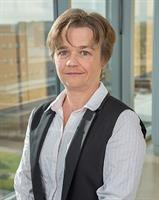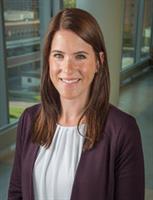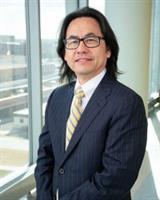Current Basic Science Mentors |
| *Mentors have clinical practices and also serve as Clinical Co-Mentors. |
Kathryn Arehart, PhD, Professor
University of Colorado Boulder, Dept. of Speech, Language, and Hearing Sciences
Dr. Arehart’s research involves hearing aid and cochlear implant outcomes for both speech and music in older adults. A particular emphasis is the role that hearing loss and cognition play in determining outcomes with hearing prosthetics. Another focus of her laboratory is applying knowledge of auditory perception (psychoacoustics) to the design and evaluation of hearing aid signal processing.
|
Linda A. Barlow, PhD, Professor
School of Medicine, Dept. Cell and Developmental Biology, RMTSC
Dr. Barlow’s laboratory has a long history of studying the cellular and molecular mechanisms underlying embryonic development and renewal of taste bud cells throughout adult life. Recently, her work has been expanded to studying taste bud stem cell regeneration after radiotherapy, a significant problem for head and neck cancer patient care, and has a recently funded NIH grant with Dr. Reyland with this focus. Radio- and chemotherapies for head and neck cancers often result in an unintended taste loss, leading to reduced quality of life. Currently the lab is investigating the impact of irradiation on cell cycle kinetics and taste cell progenitors in the lingual epithelium of wild type and mutant mice, as well as developing a behavioral assay to detect loss in taste sensitivity in irradiated mice.
|
Timothy Benke*, MD, PhD, Associate Professor
School of Medicine, Depts. of Pharmacology, Pediatrics and Neurology
Dr. Benke’s lab has developed a potential rat model of autism. In separate collaborations with Drs. Tollin and Restrepo, he will investigate abnormalities in communicative and repetitive behaviors that are typically associated with autism. In collaboration with Dr. Tollin, he will determine differences in acoustic startle and social approach in response to context specific tones (social communicative behavior). Through collaboration with Dr Restrepo, he will determine differences in olfactory behavior using a go-no go olfactory task (repetitive behavior). Either of these would be ideal projects for a trainee to provide strong foundations in acoustics, communicative behaviors, olfaction and olfactory based behaviors. Dr. Benke is also collaborating with Dr. Rennie on neural modeling of vestibular hair cells.
|
Gidon Felsen, PhD, Associate Professor
School of Medicine, Dept. of Physiology and Biophysics, RMTSC
Research in this lab focuses on the neural bases of decision making and motor control, under normal and pathological conditions. Behavioral, molecular, pharmacological, and in-vivo electrophysiological techniques are employed in rodent model systems in order to understand how representations of sensory stimuli (particularly olfactory cues) are transformed into orienting motor output. In collaboration with Dr. Klug, Dr. Felsen will employ his behavioral and molecular methods to examine the role of inhibition from auditory brainstem nuclei in low frequency sound localization.
|
Thomas Finger, PhD, Professor
School of Medicine, Dept. of Cell and Developmental Biology, RMTSC
The general scope of Dr. Finger’s research focuses on two broad interests: 1) What is the nature and function of diverse peripheral chemoreceptors, i.e. taste buds, olfactory receptor cells and solitary chemoreceptor cells? And, 2) How is sensory information from these systems transmitted to and represented within the brain? Studies in this laboratory focus on the different cell types in taste buds, their role in detection of different tastants, and how they transmit information to the taste nerves. Another project in collaboration with Dr. Sue Kinnamon, focuses on the role of solitary chemosensory cells and trigeminal nerve fibers in detection of inhaled irritants and in triggering respiratory reflexes. Finally, Dr. Finger is collaborating with Dr. Restrepo on the detection of pheromone and semiochemical signals by the main olfactory system and their transmission to the medial amygdala.
|
Dan Frank, PhD, Assistant Professor
School of Medicine, Dept. of Medicine, Div. of Infectious Diseases
The primary long-term goal of my research program is to understand how the human microbiome and the mucosal immune system interact to either nurture human health or promote disease. This work uses a variety of culture-based and culture-independent (i.e., DNA/RNA sequence-based “metagenomics”) microbiological methodologies to determine how disruption of the microbiome contributes to disease. We examine these issues primarily in the context of chronic airways diseases, specifically chronic rhinosinusitis.
|
Nathaniel Greene, PhD, Assistant Professor
School of Medicine, Dept. of Otolaryngology
The scope of Dr. Greene’s research is to explore the intersection between acoustics, mechanics of the middle ear, and auditory function, and investigate how protective and restorative devices interact with each to impact hearing. Studies utilize a wide variety of techniques including novel pressure and vibrational measurements, psychophysical testing, and physiological measurements. The goals of this research are to improve device performance, provide guidance on surgical procedures, and gain insight into auditory system function. |
Samuel Gubbels*, MD, Associate Professor
School of Medicine, Dept. of Otolaryngology
Dr. Gubbels lab is interested in using a variety of stem cell types to model the development, disease and regeneration of inner ear hair and supporting cells in vitro. His research focuses on defining a method to reliably direct the differentiation of human pluripotent stem cells into auditory hair cells and other inner ear cell types. In addition, he seeks to evaluate the ability of these cells to integrate into the appropriate areas of the inner ear upon transplantation by using a novel, developmental in vivo model system. In addition, his research uses a number of transgenic mouse models to evaluate the persistence of a population of stem cell-like cells in the adult mammalian cochlea. Dr. Gubbels believes that knowledge gained in these studies may provide important insight into how stem cells can be used to model inner ear disease and realistically pursue novel, stem cell-based therapies for hearing loss in the future.
|
Antonio Jimeno*, MD, PhD, Associate Professor
School of Medicine, Depts. of Medicine, Med. Oncology
Dr. Jimeno’s research is focused on new drug and biomarker development in Head and Neck cancer. As a physician/scientist, Dr. Jimeno’s aim is to bridge the lab and the clinic by: 1) developing direct patient xenograft models of head and neck cancers (HNC) to generate better cancer models and as a platform to study cancer stem cells, 2) conducting preclinical tests of targeted agents against de-regulated pathways and cancer stem cells, and 3) devising ways to integrate that knowledge into clinical trials to individualize anti-cancer therapy. Dr. Jimeno recently received NIH R21 grant funding to establish a direct patient xenograft model of HNC squamous cell carcinomas. He is also a co-investigator of an NIH challenge grant (with Dr. Wang, Dept. Pathology) for the identification of HNC stem cells. |
Sue Kinnamon, PhD, Professor
School of Medicine, Dept. of Otolaryngology, RMTSC
Role in this grant: Co-Program Director
Dr. Kinnamon’s laboratory focuses on two chemical sensory systems: the gustatory system and the trigeminal system. In the gustatory system, she is interested in how taste cells detect chemical stimuli, how stimuli are transduced into receptor potentials, and how this information is transmitted to gustatory afferent fibers. Studies on the trigeminal system include the function of solitary chemoreceptor cells in the nasal respiratory epithelium. These cells, which express elements of the bitter taste transduction cascade, detect noxious chemicals and bacteria in the airways and provoke trigeminally-mediated protective airway reflexes. She is currently studying the role of these cells in human airway disease, in collaboration with Drs. Ramakrishnan, Kingdom, and Finger. The laboratory uses in vitro and in vivo electrophysiological recording, calcium imaging, anatomical and molecular biological techniques to investigate these questions.
|
Achim Klug, PhD, Associate Professor
School of Medicine, Dept. of Physiology and Biophysics
The overall goal of Dr. Klug’s laboratory is to understand the role of fast and well-timed inhibition in the auditory brain stem, especially the medial nucleus of the trapezoid body (MNTB). The lab’s work of the last few years has helped understand how synaptic transmission in the MNTB system functions and is sustainable under the high activity levels that are typical for the system in-vivo. Particularly, the research project focuses on the physiology and functional role of afferent inhibitory circuits to the medial nucleus of the trapezoid body. A second project is more translational and focuses specifically on the role of these circuits in age-related hearing loss, and a third line of research explores the use of light to control neural circuits via optogenetics and quantum dots.
|
Shi-Long Lu, MD, PhD, Associate Professor
School of Medicine, Dept. of Otolaryngology
Dr. Lu’s lab is studying head and neck cancer invasion, recurrence, and metastasis. Three projects are currently on going in his lab: 1. Role of PI3K/PTEN/AKT pathway in head and neck cancer invasion and metastasis. 2. Characterization of disseminated tumor cells and metastasis initiating cells. 3. Development of biomarkers from saliva, serum, and fine needle aspirates for surveillance of HNSCC patients. He recently received an NIH RO1 grant to investigate the role of the PI3K pathway in HNC metastasis.
|
Anthony Peng, PhD, Assistant Professor
School of Medicine, Dept. of Physiology and Biophysics
The overarching goal of the lab is to determine the molecular mechanisms of the mechanotransduction process in order to provide better therapies and treatments for various causes of deafness. The mechanotransduction machinery lies within the mechanosensory organelle of hair cells called the hair bundle. To better understand the mechanotransduction mechanisms, we have made existing stimulation techniques faster and created new stimulation and analysis techniques. We use these new techniques to interrogate the molecular mechanisms of mechanotransduction adaptation and channel regulation. In addition, using these new techniques we aim to elucidate the effect of mechanical stress during noise-induced hearing loss in order to provide new therapeutic targets.
|
Katherine Rennie, PhD, Associate Professor
School of Medicine, Dept. of Otolaryngology
The Rennie laboratory studies how hair cells in the peripheral vestibular system process sensory information. The laboratory uses electrophysiological and imaging techniques to study signaling between type I vestibular hair cells and their associated afferent calyces to determine how mechanical signals at the hair cell bundle are converted into firing of action potentials in associated neurons. Vestibular efferent mechanisms and the cellular effects of gentamicin, which is particularly ototoxic to type I hair cells, are also studied. Dr. Rennie collaborates with Dr. Benke to study glutamatergic transmission at the hair cell/afferent synapse.
|
Diego Restrepo, PhD, Professor
School of Medicine, Dept. of Cell and Developmental Biology, RMTSC, Director: Center for NeuroScience, Co-Director: BRAiN Program
Systems and cellular aspects of olfaction are the focus of research in the Restrepo lab. The olfactory system performs the complex task of detecting and quantifying the concentration of volatile molecules present in the air we breathe. Olfactory sensory neurons have certain features that impart a unique advantage in the study of olfactory dysfunction and of the etiology of disorders of central nervous system function. They are the only neurons that are readily available for biopsy in adult humans, allowing investigators to sample specific clinical subpopulations. Restrepo and colleagues are currently taking advantage of these unique features to study the basic and clinical aspects of olfactory transduction in populations of normal or schizophrenic humans. He also collaborates with Dr. Ramakrishnan to study the role of ensheathing cells in olfactory regeneration.
|
Mary Reyland, PhD, Professor
School of Dental Medicine, Dept. of Craniofacial Biology
The Reyland laboratory is interested in how specific members of the protein kinase C (PKC) family function to modulate apoptosis. Using salivary epithelial cells either in culture, or derived from genetically modified mice that have specific defects in protein kinase C-directed signal transduction, the goal is to identify nuclear phosphorylation targets of PKCdelta and to understand the mechanism by which PKCδ regulates the apoptotic pathway. Studies are also underway to understand the molecular mechanisms by which PKCδ is activated during apoptosis and to identify “downstream” pathways through which protein kinase C regulates apoptotic-specific gene expression. Dr. Reyland is collaborating with the Barlow laboratory to understand the mechanisms involved in radiation-induced taste loss and recovery, and with the Jones laboratory to develop peptide and small molecule inhibitors of PKCdelta for use in protecting salivary gland tissue and function in HNC patients treated with irradiation.
|
Regie Santos-Cortez, MD, PhD, Associate Professor
School of Medicine, Dept. Otolaryngology
Regie's research interests include the identification of genetic variants that: (1) confer susceptibility to otitis media; (2) induce microbial shifts in the middle ear; (3) are correlated with differences in audiologic profiles and temporal bone abnormalities in cochlear implantees. These studies are supported by DNA, RNA and microbiome next-generation sequencing and followed up using Sanger sequencing and statistical analyses including family-based and association tests.
|
Nathan Schoppa, PhD, Professor
School of Medicine, Dept. of Physiology and Biophysics
Research in the Schoppa lab focuses on investigating the cellular and circuit mechanisms that regulate the input-output functions of various brain regions involved in olfaction. We use in vitro and in vivo physiological, molecular, optogenetic, and computational approaches to answer these questions.
|
Anu Sharma, PhD, CCC-A, Professor
University of Colorado at Boulder, Dept. of Speech Language and Hearing Science and the Institute for Cognitive Neuroscience
Dr. Sharma’s laboratory at the University of Colorado at Boulder campus conducts research on central auditory development, plasticity and re-organization in patients with hearing loss and auditory neuropathy spectrum disorder who receive intervention via cochlear implants and hearing aids. In collaboration with Dr. Jenkins, Dr. Sharma uses electrophysiologic measures including cortical auditory evoked potentials (CAEP) and high-density electroencephalography (EEG) to examine cortical organization and its relationship to behavioral outcomes in patients with hearing loss. Dr. Sharma’s laboratory is also conducting translational research to develop objective CAEP biomarkers of central auditory maturation in infants and young children designed to evaluate the effectiveness of intervention via amplification and/or electrical stimulation in pediatric hearing-impaired populations.
|
Daniel Tollin, PhD, Professor
School of Medicine, Dept of Physiology and Biophysics
The goal of the work in the Tollin lab is to understand the neural mechanisms of auditory perception with particular emphasis on how sources of sounds are localized. Because the peripheral auditory apparatus has no mechanism to directly sense direction, sound location must be computed at more central levels. This makes sound localization a fascinating neurocomputational problem, particularly from a developmental perspective. Multidisciplinary approaches are used to tackle these questions employing both experimental and theoretical techniques including human and animal psychophysics, extracellular physiology, signal detection and information theory, systems identification techniques, acoustic transfer function measurement and modeling, digital filter design and estimation, acoustic signal design, and physiological systems modeling. The lab is also collaborating with Drs. Jenkins, Cass and Gubbels to research methods to optimize the performance of implantable hearing devices using both animal and human cadaveric temporal bone models.
|
Kristin Uhler*, PhD, Associate Professor
School of Medicine, Depts. of Otolaryngology and Physical Medicine and Rehabilitation
Dr. Uhler’s research focuses on speech perception in deaf and hard-of-hearing listeners and the impact of intervention on their abilities to discriminate speech. Dr. Uhler recently received a K23 award to develop a biomarker for infant speech perception in children with hearing loss Dr. Uhler collaborates extensively with other OTP Mentors in the Dept. of Speech, Language and Hearing in Boulder and works with Dr. Anderson in the Audiology clinic at the Anschutz Medical Campus. She is also collaborating with Drs. Klug and Jenkins on a translational research project that focuses on the roles of the circuits in presbycusis for both localizing the noise source and the impacts this has on older listeners’ performance. |
Sukumar Vijayaraghavan, PhD, Professor
School of Medicine, Dept of Physiology and Biophysics. Director, Neuroscience Graduate Program, RMTSC
The Vijayaraghavan lab works on nicotinic cholinergic receptors in the mammalian olfactory system. The receptors are involved in olfactory learning and memory. Disruption of the receptor function leads to a loss of olfactory perceptual learning in mice. The mechanisms underlying this modulation and the activation of these receptors by the endogenous transmitter are unknown. He uses a combination of electrophysiology, live cell imaging, genetic mouse models and optogenetics to dissect pathways and mechanisms underlying the function of this essential pathway in the brain. A second line of research in the lab aims at deciphering the mechanistic link between olfactory dysfunction and neurodegenerative diseases.
|
Xiao-Jing Wang, MD, PhD, Professor
School of Medicine, Dept of Pathology
Director, Head and Neck Cancer Research Program
Dr. Wang’s laboratory has developed several genetically engineered mouse models mimicking human head and neck squamous cell carcinomas (HNSCC). These mouse models have added an invaluable resource for evaluating the mechanisms and efficacy of existing clinical trials for HNSCC prevention and treatments. Research in the Wang laboratory includes: 1) Identification of biomarkers for diagnosis and therapy for human HNC, 2) Development of animal models for HNC, 3) Molecular mechanisms of HNC including the properties of cancer stem cells, transcriptional machinery and microRNA functions, and 4) Experimental therapeutics of HNC.
|








